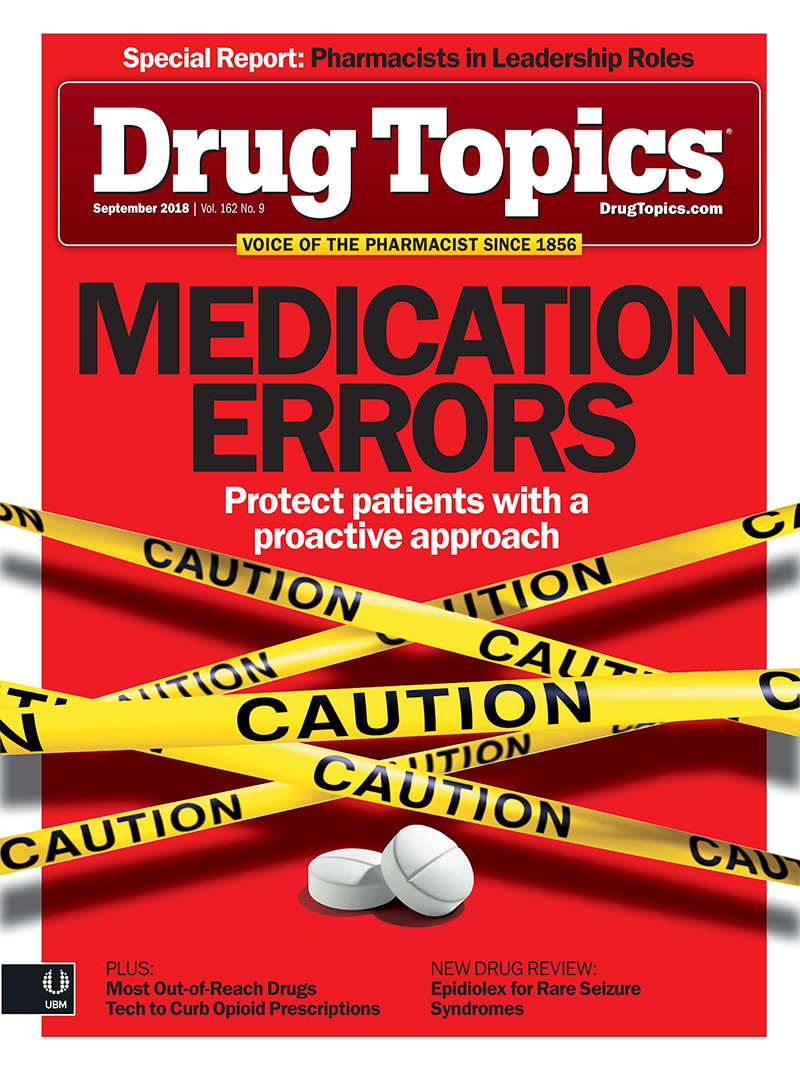Online Pharmacies, Formulary Exclusions, and More News
The September Small Doses brings you the latest news that affects pharmacists.

Express Scripts’ 2019 Formulary Exclusions
Express Scripts’ 2019 National Preferred Formulary excludes certain blockbuster drugs. It also removes new categories of medications that the PBM had shied away from excluding in the past.
The annual list of excluded medications encompasses 48 new medications, including the anticoagulant dabigatran (Pradaxa), the hepatitis C medication sofosbuvir (Sovaldi), and the HIV antiviral combo drug efavirenz/emtricitabine/tenofovir disoproxil fumarate (Atripla).
New therapy areas with excluded drugs include hemophilia, HIV, and hereditary angioedema.
Related article: Pharmacy Community Reacts to Cigna/Express Scripts Deal
“The reasons for the exclusions are likely multifactorial. One reason could be changes in cost, but it may also be due to the increased competition within the class,” Jeremy Schafer, PharmD, senior vice president at Precision for Value, tells Drug Topics.
Schafer is concerned about the exclusion of drugs for rare diseases, such as hemophilic factor (Xyntha) for hemophilia A, and C1 esterase inhibitor (Berinert) for hereditary angioedema. “Patients may be started on these products in the hospital and then discharged home. Will the patient be stopped by an exclusion and have a delay in therapy as the doctor files for a prior authorization or considers an alternative?”
However, Express Scripts says formulary preference is given to high-value therapies with the lowest net cost for clients, achieved through low list price, rebate or both. For example, efavirenz/lamivudine/ tenofovir disoproxil fumarate (Symfi, and Symfi Lo) are preferred to treat HIV-1. Those medications have 40% lower list prices than Atripla.
Meanwhile, CVS Health will likely announce its 2019 formulary changes in early October. It is expected to exclude 23 drugs, and add four.
CVS MinuteClinic Adds Video Visits
CVS Health’s MinuteClinic recently launched Video Visits, which will provide patients with access to healthcare services 24 hours a day from their mobile devices.
MinuteClinic partnered with Teladoc to offer Video Visits, which are initiated through the CVS Pharmacy app. “Patients who opt to seek care through a fully customized MinuteClinic Video Visit experience the same high-quality, evidence-based care they receive at traditional MinuteClinic locations inside select CVS Pharmacy and Target stores,” CVS Health says.
Related article: Telepharmacy Use Soars
The Telehealth service is for patients with minor illnesses and injuries. MinuteClinic charges $59 for the visits, and will add insurance coverage over the next few months.
The service is available in nine states-Arizona, California, Florida, Idaho, Maine, Maryland, Mississippi, New Hampshire, and Virginia-and Washington, DC. CVS Health expects Video Visits to be available nationwide, where allowed, by the end of this year.
Online Pharmacy Delivery Service Threatens Amazon, Drug Stores
Amazon and PillPack have yet another major competitor in the growing online pharmacy business-and drug store chains have reason to be concerned.
New York-based Capsule, which boasts same-day delivery for prescriptions and a frictionless, personal pharmacy experience, recently landed $50 million in funding. The funding boost will allow Capsule, currently operating in New York City, to expand nationwide in the future.
After Amazon acquired PillPack, which delivers medications in presorted dose packaging and coordinates refills and renewals, earlier this summer, drug store chains’ stock sank. CVS Health, Walgreens Boots Alliance, and Rite Aid collectively lost more than $11 billion in stock market value the day the news was announced.
Capsule Founder and CEO Eric Kinariwala doesn’t seem fazed by competitors such as PillPack. “We’re definitely excited to see that Amazon has entered the space with PillPack, as its further validation that the conventional pharmacy experience is broken. Increased momentum toward fixing the problem is great for everybody,” he tells Drug Topics.
Related article: What Amazon’s PillPack Acquisition Means for Your Pharmacy
Capsule differs from other online pharmacies and traditional brick-and-mortar drug stores, Kinariwala contends. “Traditionally, digital commerce companies have used their technology to remove human interaction, but at Capsule, we’ve built our platform to amplify its power in your healthcare.”
For example, Capsule handles patients’ prescription refills, and coordinates with doctors and insurance companies, so consumers don’t have to deal with them when filling scripts. It promises to provide caring, friendly service in which consumers “never have to wait in line again.” The company website says, “Never talk to a voicemail autobot. Text, call, email, or chat with your pharmacist whenever is convenient.”
In addition, Capsule is not simply “layering on” delivery services, like many conventional pharmacies, Kinariwala says. “Our view is that delivery will become a commodity and that it is only part of the solution. Where Capsule differentiates is that it’s been specifically designed to connect humans and technology at every point to create value for all the stakeholders in healthcare.”
Contaminated Synthetic Marijuana Products Killing Users
The FDA is warning about severe illnesses and deaths from the use of contaminated synthetic cannabinoid (marijuana) products.
The products, sold at convenience stores and gas stations, are contaminated with brodifacoum, a very long-acting anticoagulant commonly used in rat poison. The marijuana substitutes are sold under the names “K2,” “Spice,” and others.
Over the past few months, hundreds of individuals in about 10 states have been hospitalized after experiencing severe bleeding. Several deaths have also been reported, according to a statement from the FDA Commissioner Scott Gottlieb, MD, and other officials.
“Use of these illegal products pose significant public health concerns for both individuals who may use the contaminated products and the U.S. blood supply, as there is the potential for contamination of blood products donated by those individuals who have used these substances,” say the FDA officials.
A number of synthetic marijuana products are being illegally marketed. The FDA has worked with the DEA to place several synthetic cannabinoids into Schedule I of the Controlled Substances Act to avoid an imminent hazard to public safety.
“Individuals who have possibly used synthetic marijuana products should be vigilant for signs of bleeding. These include easy bruising, oozing gums, and nose bleeds. People experiencing these symptoms after using synthetic marijuana products should immediately seek medical attention, as the effects of brodifacoum are treatable,” Gottlieb and his colleagues say.
“We also want to alert healthcare providers, particularly those delivering care in emergency settings, to be aware of these risks and consider the possibility of synthetic cannabinoid exposure when individuals present with unexplained bleeding. Standard coagulation tests, such as the prothrombin time, can be dramatically elevated in these settings, and prompt treatment with high doses of vitamin K and other supportive care can potentially be life-saving,” Gottlieb and his colleagues add.
Opioid Dosages Increase, Despite Awareness
The dosages of opioids increased over a 10-year period in the United States, particularly among disabled Medicare beneficiaries.
In the study, published in the August 1 issue of BMJ, lead author Molly Moore Jeffery, PhD, scientific director of emergency care research at Mayo Clinic, wrote that disabled Medicare beneficiaries had the highest rates of opioid use, the highest rate of long-term use, and the largest average daily dose.
The retrospective cohort study of administrative claims data examined opioid prescribing trends from 2007 to 2016. Researchers examined data from 48 million individuals, including commercial beneficiaries, Medicare Advantage beneficiaries aged 65 years and older, and Medicare Advantage beneficiaries less than 65 years old (due to permanent disability).
In the group of patients on permanent disability, both quarterly use rates (39%) and average daily dose (56 mg morphine equivalents or MME) were higher at the end of 2016 than the low points observed in 2007 for each end point (26% prevalence and 53 MME).
“Opioid use and average daily dose have not substantially declined from their peaks, despite increased attention to opioid abuse and awareness of their risks,” Jeffery writes.
How Patients Really Feel About Opioid vs. Nonopioid Meds for Chronic Pain
A new study investigated pre-existing perceptions about pain medications by individuals with chronic pain and how these perceptions relate to patients’ experiences with these medications.
The study, published online in the Journal of Pain, the journal of the American Pain Society, found that, despite strongly held beliefs about opioid and nonopioid medications, patients were often surprised by their results.
The study provides insights into the results of “The Strategies for Prescribing Analgesics Comparative Effectiveness” (SPACE) trial, which compared benefits and harms of opioid versus nonopioid medications over 12 months for chronic musculoskeletal pain. SPACE found that opioid meds were not better at improving pain that interfered with walking, work, or sleep over 12 months for individuals with chronic back pain or arthritic hips or knees compared to nonopioid medications. SPACE also found that adverse medication-related symptoms were more common in the patients who took opioids.
Related article: Four Ways Pharmacists Are Fighting Opioid Abuse
For the Journal of Pain study, Marianne Matthias, PhD, Regenstrief Institute investigator, and colleagues, interviewed 34 SPACE participants, all of whom were patients at a VA hospital.
“Patients’ expectations do not always match their experiences,” says Matthias. “Patients in this study, who for the most part believed that opioids were the strongest pain medicines available-even if they didn’t want to take them-were often surprised when either: 1) the opioids didn’t work as well as they thought (for patients randomized to the opioid arm), or 2) when nonopioids, such as NSAIDS or topical creams, helped reduce their pain much more than expected (for patients randomized to the nonopioid study arm). Most patients seemed not to be aware of the large number of options available to them or that many of these (nonopioid) options can actually be quite effective for pain relief.”
In addition, patients in many cases learned that function was more important than pain levels, according to Matthias. “In other words, some patients described having lower pain on opioids but not being able to do much of anything because of the lethargy associated with these medications. On the other hand, some patients who took nonopioids described being able to do more-be active, play with their kids, etc. It would be important . . . to work to manage patients’ expectations to keep patients open to trying a number of other treatment options, and to shift patients’ focus from pain levels/intensity to function, i.e., what they are able to do.”
